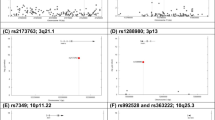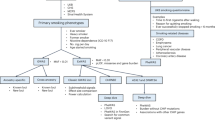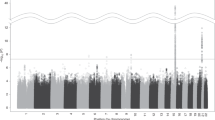Abstract
The ability to quit smoking is heritable, yet few genetic studies have investigated prospective smoking cessation. We conducted a systems-based genetic association analysis in a sample of 472 treatment-seeking smokers of European ancestry after 8 weeks of transdermal nicotine therapy for smoking cessation. The genotyping panel included 169 single-nucleotide polymorphisms (SNPs) in 7 nicotinic acetylcholine receptor subunit genes and 4 genes in the endogenous cholinergic system. The primary outcome was smoking cessation (biochemically confirmed) at the end of treatment. SNPs clustered in the choline acetyltransferase (ChAT) gene were individually identified as nominally significant, and a 5-SNP haplotype (block 6) in ChAT was found to be significantly associated with quitting success. Single SNPs in ChAT haplotype block 2 were also associated with pretreatment levels of nicotine dependence in this cohort. To replicate associations of SNPs in haplotype blocks 2 and 6 of ChAT with nicotine dependence in a non-treatment-seeking cohort, we used data from an independent community-based sample of 629 smokers representing 200 families of European ancestry. Significant SNP and haplotype associations were identified for multiple measures of nicotine dependence. Although the effect sizes in both cohorts are modest, converging data across cohorts and phenotypes suggest that ChAT may be involved in nicotine dependence and ability to quit smoking. Additional sequencing and characterization of ChAT may reveal functional variants that contribute to nicotine dependence and smoking cessation.
Similar content being viewed by others
Log in or create a free account to read this content
Gain free access to this article, as well as selected content from this journal and more on nature.com
or
References
Alderson HL, Latimer MP, Winn P (2006). Intravenous self-administration of nicotine is altered by lesions of the posterior, but not anterior, pedunculopontine tegmental nucleus. Eur J Neurosci 23: 2169–2175.
Arnold HM, Nelson CL, Sarter M, Bruno JP (2003). Sensitization of cortical acetylcholine release by repeated administration of nicotine in rats. Psychopharmacology (Berl) 165: 346–358.
Baker TB, Weiss RB, Bolt D, von Niederhausern A, Fiore MC, Dunn DM et al (2009). Human neuronal acetylcholine receptor A5-A3-B4 haplotypes are associated with multiple nicotine dependence phenotypes. Nicotine Tob Res 11: 785–796.
Barrett JC, Fry B, Maller J, Daly MJ (2005). Haploview: analysis and visualization of LD and haplotype maps. Bioinformatics 21: 263–265.
Beuten J, Ma JZ, Payne TJ, Dupont RT, Crews KM, Somes G et al (2005). Single- and multilocus allelic variants within the GABA(B) receptor subunit 2 (GABAB2) gene are significantly associated with nicotine dependence. Am J Hum Genet 76: 859–864.
Breitling LP, Dahmen N, Mittelstrass K, Illig T, Rujescu D, Raum E et al (2009). Smoking cessation and variations in nicotinic acetylcholine receptor subunits alpha-5, alpha-3, and beta-4 genes. Biol Psychiatry 65: 691–695.
Brown R, Burgess E, Sales S, Whiteley J (1998). Reliability and validity of a smoking timeline follow-back interview. Addict Behav 12: 101–112.
Buisson B, Bertrand D (2002). Nicotine addiction: the possible role of functional upregulation. Trends Pharmacol Sci 23: 130–136.
Conti DV, Lee W, Li D, Liu J, Van Den Berg D, Thomas PD et al (2008). Nicotinic acetylcholine receptor beta2 subunit gene implicated in a systems-based candidate gene study of smoking cessation. Hum Mol Genet 17: 2834–2848.
Corrigall WA, Coen KM, Zhang J, Adamson L (2002). Pharmacological manipulations of the pedunculopontine tegmental nucleus in the rat reduce self-administration of both nicotine and cocaine. Psychopharmacology (Berl) 160: 198–205.
David SP, Strong DR, Munafo MR, Brown RA, Lloyd-Richardson EE, Wileyto PE et al (2007). Bupropion efficacy for smoking cessation is influenced by the DRD2 Taq1A polymorphism: analysis of pooled data from two clinical trials. Nicotine Tob Res 9: 1251–1257.
Diehl A, Nakovics H, Croissant B, Smolka MN, Batra A, Mann K (2006). Galantamine reduces smoking in alcohol-dependent patients: a randomized, placebo-controlled trial. Int J Clin Pharmacol Ther 44: 614–622.
Etter JF, Hoda JC, Perroud N, Munafo M, Buresi C, Duret C et al (2009). Association of genes coding for the alpha-4, alpha-5, beta-2 and beta-3 subunits of nicotinic receptors with cigarette smoking and nicotine dependence. Addict Behav 34: 772–775.
Excoffier L, Slatkin M (1995). Maximum-likelihood estimation of molecular haplotype frequencies in a diploid population. Mol Biol Evol 12: 921–927.
Exley R, Cragg SJ (2008). Presynaptic nicotinic receptors: a dynamic and diverse cholinergic filter of striatal dopamine neurotransmission. Br J Pharmacol 153 (Suppl 1): S283–S297.
Foulkes AS (2009). Applied Statistical Genetics with R: For Population Based Association Studies. Springer Science: New York.
Gabriel SB, Schaffner SF, Nguyen H, Moore JM, Roy J, Blumenstiel B et al (2002). The structure of haplotype blocks in the human genome. Science 296: 2225–2229.
Greenbaum L, Kanyas K, Karni O, Merbl Y, Olender T, Horowitz A et al (2006). Why do young women smoke? I. Direct and interactive effects of environment, psychological characteristics and nicotinic cholinergic receptor genes. Mol Psychiatry 11: 312–322, 223.
Harold D, Macgregor S, Patterson CE, Hollingworth P, Moore P, Owen MJ et al (2006). A single nucleotide polymorphism in CHAT influences response to acetylcholinesterase inhibitors in Alzheimer′s disease. Pharmacogenet Genomics 16: 75–77.
Heath AC, Martin NG (1993). Genetic models for the natural history of smoking: evidence for a genetic influence on smoking persistence. Addict Behav 18: 19–34.
Heatherton TF, Kozlowski LT, Frecker RC, Fagerstrom KO (1991). The Fagerstrom test for nicotine dependence: a revision of the Fagerstrom Tolerance Questionnaire. Br J Addict 86: 1119–1127.
Heitjan DF, Guo M, Ray R, Wileyto EP, Epstein LH, Lerman C (2008). Identification of pharmacogenetic markers in smoking cessation therapy. Am J Med Genet B Neuropsychiatr Genet 147B: 712–719.
Hernandez CM, Terry Jr AV (2005). Repeated nicotine exposure in rats: effects on memory function, cholinergic markers and nerve growth factor. Neuroscience 130: 997–1012.
Horvath S, Xu X, Lake SL, Silverman EK, Weiss ST, Laird NM (2004). Family-based tests for associating haplotypes with general phenotype data: application to asthma genetics. Genet Epidemiol 26: 61–69.
Huang W, Payne TJ, Ma JZ, Beuten J, Dupont RT, Inohara N et al (2009). Significant association of ANKK1 and detection of a functional polymorphism with nicotine dependence in an African-American sample. Neuropsychopharmacology 34: 319–330.
Hutchison KE, Allen DL, Filbey FM, Jepson C, Lerman C, Benowitz NL et al (2007). CHRNA4 and tobacco dependence: from gene regulation to treatment outcome. Arch Gen Psychiatry 64: 1078–1086.
Johnstone EC, Elliot KM, David SP, Murphy MF, Walton RT, Munafo MR (2007). Association of COMT Val108/158Met genotype with smoking cessation in a nicotine replacement therapy randomized trial. Cancer Epidemiol Biomarkers Prev 16: 1065–1069.
Jonk YC, Sherman SE, Fu SS, Hamlett-Berry KW, Geraci MC, Joseph AM (2005). National trends in the provision of smoking cessation aids within the Veterans Health Administration. Am J Manag Care 11: 77–85.
Lange C, Silverman EK, Xu X, Weiss ST, Laird NM (2003). A multivariate family-based association test using generalized estimating equations: FBAT-GEE. Biostatistics 4: 195–206.
Lerman C, Jepson C, Wileyto EP, Epstein LH, Rukstalis M, Patterson F et al (2006). Role of functional genetic variation in the dopamine D2 receptor (DRD2) in response to bupropion and nicotine replacement therapy for tobacco dependence: results of two randomized clinical trials. Neuropsychopharmacology 31: 231–242.
Lerman C, Wileyto EP, Patterson F, Rukstalis M, Audrain-McGovern J, Restine S et al (2004). The functional mu opioid receptor (OPRM1) Asn40Asp variant predicts short-term response to nicotine replacement therapy in a clinical trial. Pharmacogenomics J 4: 184–192.
Li MD, Beuten J, Ma JZ, Payne TJ, Lou XY, Garcia V et al (2005). Ethnic- and gender-specific association of the nicotinic acetylcholine receptor alpha4 subunit gene (CHRNA4) with nicotine dependence. Hum Mol Genet 14: 1211–1219.
Li MD, Cheng R, Ma JZ, Swan GE (2003). A meta-analysis of estimated genetic and environmental effects on smoking behavior in male and female adult twins. Addiction 98: 23–31.
Li MD, Ma JZ, Payne TJ, Lou XY, Zhang D, Dupont RT et al (2008). Genome-wide linkage scan for nicotine dependence in European Americans and its converging results with African Americans in the Mid-South tobacco family sample. Mol Psychiatry 13: 407–416.
Li Q, Yu K (2008). Improved correction for population stratification in genome-wide association studies by identifying hidden population structures. Genet Epidemiol 32: 215–226.
Lin S, Chakravarti A, Cutler DJ (2004). Exhaustive allelic transmission disequilibrium tests as a new approach to genome-wide association studies. Nat Genet 36: 1181–1188.
Mancama D, Mata I, Kerwin RW, Arranz MJ (2007). Choline acetyltransferase variants and their influence in schizophrenia and olanzapine response. Am J Med Genet B Neuropsychiatr Genet 144B: 849–853.
Nestler EJ (2005). Is there a common molecular pathway for addiction? Nat Neurosci 8: 1445–1449.
Nussbaum J, Xu Q, Payne TJ, Ma JZ, Huang W, Gelernter J et al (2008). Significant association of the neurexin-1 gene (NRXN1) with nicotine dependence in European- and African-American smokers. Hum Mol Genet 17: 1569–1577.
Ohno K, Tsujino A, Brengman JM, Harper CM, Bajzer Z, Udd B et al (2001). Choline acetyltransferase mutations cause myasthenic syndrome associated with episodic apnea in humans. Proc Natl Acad Sci USA 98: 2017–2022.
Piasecki TM (2006). Relapse to smoking. Clin Psychol Rev 26: 196–215.
Purcell S, Neale B, Todd-Brown K, Thomas L, Ferreira MA, Bender D et al (2007). PLINK: a tool set for whole-genome association and population-based linkage analyses. Am J Hum Genet 81: 559–575.
Rowell PP, Winkler DL (1984). Nicotinic stimulation of [3H]acetylcholine release from mouse cerebral cortical synaptosomes. J Neurochem 43: 1593–1598.
Saccone NL, Wang JC, Breslau N, Johnson EO, Hatsukami D, Saccone SF et al (2009). The CHRNA5-CHRNA3-CHRNB4 nicotinic receptor subunit gene cluster affects risk for nicotine dependence in African-Americans and in European-Americans. Cancer Res 69: 6848–6856.
Saccone SF, Hinrichs AL, Saccone NL, Chase GA, Konvicka K, Madden PA et al (2007). Cholinergic nicotinic receptor genes implicated in a nicotine dependence association study targeting 348 candidate genes with 3713 SNPs. Hum Mol Genet 16: 36–49.
Schaid DJ, Rowland CM, Tines DE, Jacobson RM, Poland GA (2002). Score tests for association between traits and haplotypes when linkage phase is ambiguous. Am J Hum Genet 70: 425–434.
Schlesselman JJ (1982). Case-Control Studies: Design, Conduct, Analysis. Oxford University Press: New York.
Schlesselman JJ (1987). Re: smallest detectable relative risk with multiple controls per case. Am J Epidemiol 125: 348.
Schnoll RA, Lerman C (2006). Current and emerging pharmacotherapies for treating tobacco dependence. Expert Opin Emerg Drugs 11: 429–444.
Schnoll RA, Patterson F, Wileyto EP, Tyndale RF, Benowitz N, Lerman C (2009). Nicotine metabolic rate predicts successful smoking cessation with transdermal nicotine: a validation study. Pharmacol Biochem Behav 92: 6–11.
Slotkin TA, Bodwell BE, Ryde IT, Seidler FJ (2008). Adolescent nicotine treatment changes the response of acetylcholine systems to subsequent nicotine administration in adulthood. Brain Res Bull 76: 152–165.
Spitzer R, Williams J, Gibbon M (1990). Structured Clinical Interview for DSM-R Non-Patient Edition (SCID-NP, Version 1.0). American Psychiatric Press: Washington DC.
SRNT (2002). Subcommittee on biochemical verification. Biochemical verificaition of tobacco use and cessation. Nicotine Tob Res 4: 149–159.
Stead LF, Perera R, Bullen C, Mant D, Lancaster T (2008). Nicotine replacement therapy for smoking cessation. Cochrane Database Syst Rev 1: CD000146.
Tani Y, Saito K, Imoto M, Ohno T (1998). Pharmacological characterization of nicotinic receptor-mediated acetylcholine release in rat brain--an in vivo microdialysis study. Eur J Pharmacol 351: 181–188.
Thorgeirsson TE, Geller F, Sulem P, Rafnar T, Wiste A, Magnusson KP et al (2008). A variant associated with nicotine dependence, lung cancer and peripheral arterial disease. Nature 452: 638–642.
West R, DiMarino ME, Gitchell J, McNeill A (2005). Impact of UK policy initiatives on use of medicines to aid smoking cessation. Tob Control 14: 166–171.
Xian H, Scherrer JF, Madden PA, Lyons MJ, Tsuang M, True WR et al (2003). The heritability of failed smoking cessation and nicotine withdrawal in twins who smoked and attempted to quit. Nicotine Tob Res 5: 245–254.
Acknowledgements
This study was supported by the following grants from NIH P50 CA/DA84718 and P50 CA143187 (CL), NIH DA012844 (MDL), NIH U01DA020830, and a grant from the Pennsylvania Department of Health. The Department specifically disclaims responsibility for any analysis, interpretations or conclusions.
Author information
Authors and Affiliations
Corresponding author
Ethics declarations
Competing interests
Dr Mitra has served as a consultant to the US National Institutes of Health and Cornell University. Dr Baldwin has served as a consultant to Boekel Scientific, University of California Los Angeles, MEDACorp, Guidepoint Global, and the US National Institutes of Health. Dr Guo has received funding from the Dana-Farber Cancer Institute, and the Department of Biostatistics and Computational Biology at the University of Pennsylvania. Dr Heitjan has served as a consultant to Columbia University, Louisiana State University, University of Maryland Cancer Center, University at Stony Brook, Centocor, Executive Health Exams International, Merck, American College of Physicians, Thoratec, Deutsche Bank, Mintz Levin, Amgen, Shaman Capital, ASCO/AACR, Apopharma, Susan G Komen For the Cure, the US National Institutes of Health, and Ravgen. Dr Payne receives compensation from the University of Mississippi Medical Center; part of his salary has been supported by grants from NIDA, NCI, the University of Mississippi Health Care Cancer Institute, the Mississippi State Department of Health, Pfizer, and Glaxosmithkline. Dr Li has served as a consultant to NIH, DeCODE genetics, University of Pennsylvania, Reckitt Benckiser Pharmaceuticals, Pennsylvania Department of Health, and Informational Managements Consulting. Dr Li also serves as a scientific advisor to ADial Pharmaceuticals. Dr Lerman has served as a consultant and/or has received research funding from Pfizer, AstraZeneca, GlaxoSmithKline, Targacept, and Novartis. In the past 3 years Dr Lerman has received compensation for professional services from the National Institutes of Health, University of North Carolina, Memorial Sloan Kettering Cancer Center, American Association of Cancer Research, Case-Western Reserve University, Washington University in St Louis, University of Virginia, Northwestern University, University of Illinois at Chicago, University of Chicago, Mayo Clinic, Rutgers University, Georgia Cancer Coalition, Cancer Prevention Research Institute of Texas, and Duke University. This study was not supported by industry funds. The remaining authors declare no conflict of interest.
Additional information
Supplementary Information accompanies the paper on the Neuropsychopharmacology website
Rights and permissions
About this article
Cite this article
Ray, R., Mitra, N., Baldwin, D. et al. Convergent Evidence that Choline Acetyltransferase Gene Variation is Associated with Prospective Smoking Cessation and Nicotine Dependence. Neuropsychopharmacol 35, 1374–1382 (2010). https://doi.org/10.1038/npp.2010.7
Received:
Revised:
Accepted:
Published:
Issue date:
DOI: https://doi.org/10.1038/npp.2010.7
Keywords
This article is cited by
-
Modulation Effect of HIV-1 Viral Proteins and Nicotine on Expression of the Immune-Related Genes in Brain of the HIV-1 Transgenic Rats
Journal of Neuroimmune Pharmacology (2016)
-
Biomarkers of Response to Smoking Cessation Pharmacotherapies: Progress to Date
CNS Drugs (2015)
-
APOE ɛ4, an Alzheimer’s disease susceptibility allele, and smoking cessation
The Pharmacogenomics Journal (2013)
-
Pharmacogenetic Association of the Galanin Receptor (GALR1) SNP rs2717162 with Smoking Cessation
Neuropsychopharmacology (2012)
-
Smoking Cessation Pharmacogenetics: Analysis of Varenicline and Bupropion in Placebo-Controlled Clinical Trials
Neuropsychopharmacology (2012)



